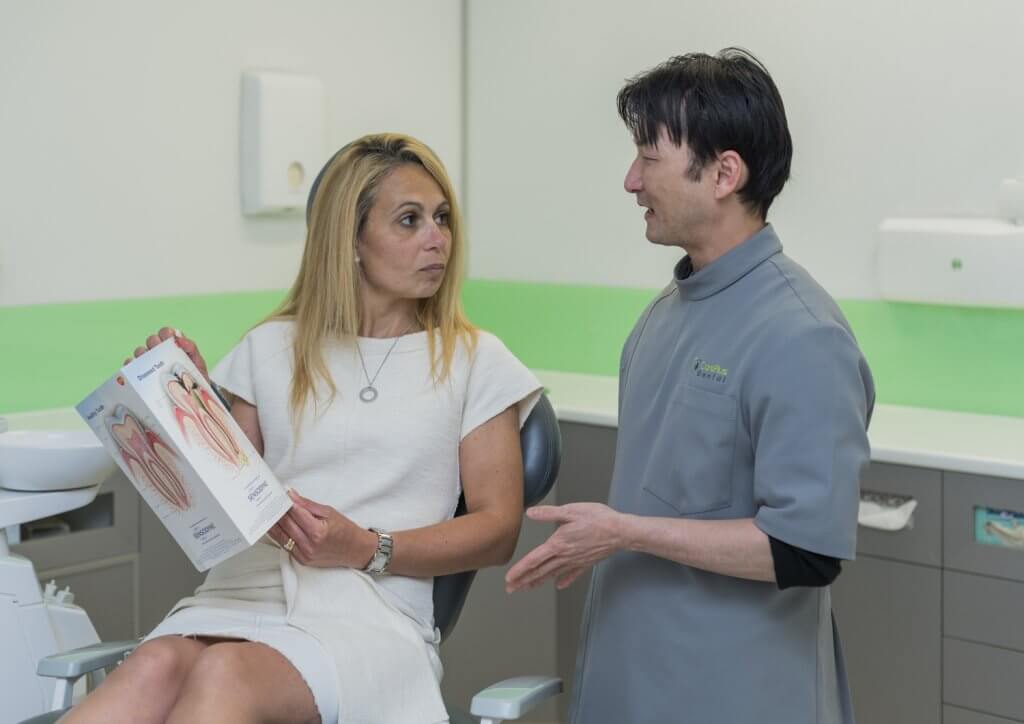A root canal treated tooth may last many, many years with good care. The root canal treated tooth is like the other teeth in your mouth as it can still decay and be subject to gum disease.
All dentists are trained to do root canal treatments. Endodontists are specialist dentists whose area of expertise is root canal treatment.
An infection in the root canal of a tooth can cause:
- a swelling with pus in the area around the tooth root
- a swelling that may spread to other areas of the face or neck or head
- bone loss around the tip of the root of the tooth
- a drain hole (called a sinus) between the root of the infected tooth and outside the bone. This can be through the side of the tooth into the periodontium or through to the cheek or tongue areas.
Root canal treatment doesn’t only aim to get rid of the result of the infection e.g. pain and swelling, but it aims to get rid of the cause of the infection. This is done by cleaning the damaged pulp or debris from the root canal and sealing the root canal against bacteria (germs).
Antibiotics may temporarily get rid of the pain or swelling but without treatment the infection continues.
What happens when the nerve in the tooth ‘dies’ or you get an abscess?
When the pulp in the tooth is destroyed or “dies” the inside (pulp chamber or root canal) becomes empty or full of “dead” (necrotic) body fluids. Bacteria finds this space and starts to grow. The bodys defense mechanisms can not remove the bacteria so an infection forms.
Common causes of pulp damage:
- Decay occurring close to the pulp (nerves and blood vessels inside the tooth)- unfortunately this is not always deep cavities. The shape of some teeth result in the pulp being close to the surface of the tooth.
- Trauma (accidents) . Moderate trauma may cause injury to the pulp that the body will be able to repair. Sometimes the pulp in the tooth ‘dies’ years after trauma and the mechanisms and reasons are not always well understood.
- Effect of having large restorations or fillings over a period of time
- Irritation over an extended time
Non-painful death!
Some people have pulp damage without any symptoms. They have no pain. A dentist may discover a ‘dead’ tooth via radiographs (x-rays) showing bone destruction or in finding a very loose tooth or finding pus formation or a hole in the bone near a tooth that releases pus slowly (draining sinus).
Attention should be paid to removing the infection and healing the bone. Long term dental infections have been linked to heart attacks and strokes.
Why do I have pain if my tooth is dead?
Tooth pain that may result in the need for endodontic treatment may include:
- Sensitivity to cold and hot. Severe pain which lasts for some time after the hot or cold has been removed is a sign that the pulp may have irreversible damage. Sensitivity to hot and cold may also be due to dental decay, gum recession or a tooth crack.
- Pain on chewing or pressure. This may also indicate a crack in a tooth, or periodontal disease or a endodontic abscess.
Prolonged pain sensitivity to hot and cold is usually one of the early symptoms of pulp damage. The pulp is ‘alive’ at this stage but the damage to it has been so great that the pulp tissue is unable to heal itself and will continue getting worse until it degenerates totally and ‘dies’. Hot and cold expands and contacts the pulp tissue causing pain. Often at this stage hot causes pain which may take minutes to subside and this may be relieved by the placement of cold on the tooth. In an undamaged pulp the tissue has mechanisms to control this expansion/contraction so pain isn’t experienced.
The cause of pain once a tooth ‘dies’ is the pressure, of the ‘dead’ contents of the inside of the tooth (consisting of dead pulp tissue, debris, and bacteria), on the surrounding bone and gums (periodontal ligament ) so the tooth often feels painful to touch yet may not be sensitive to changes in temperature. Symptoms most commonly associated with a ‘dead’ nerve are a tooth that hurts to bite on, becomes sore to touch or push on, and in acute stages facial swelling occurs.
What’s involved in root canal (endodontic) treatment?
Before treatment commences a dentist or specialist endodontist will try to determine whether a tooth is likely to be able to be successfully treated and to be restored as a functional or cosmetic part of your mouth. This is done using radiographs (x-rays), visual examination and periodontal examinations.
The treatment process is as follows:
- Small holes are created in the top part of the tooth, giving access to the canals of the tooth.
- The affected pulp is removed and the canals are thoroughly cleaned and irrigated with an anti-bacterial preparation
- The canals are filled with a synthetic material which provides a seal
Completion of treatment
Once the root canal treatment is completed we may require monitoring the healing process with additional xrays.
Crowns
We may recommend you have the root canal treated tooth crowned to improve the strength and decrease the risk of the tooth fracturing.
Possible complications of root canal treatment
Please speak to us about any concerns you have with root canal treatment.
All dental and medical treatment has risks and as a unique part of your unique makeup each tooth is different so not every complication can be listed.
- No guarantee of success
- In many cases the success rate has been shown to be approximately 90%. We do not always know until after treatment has been completed if it will be successful or not. Microscopic variations in the internal structure of each tooth contribute to the failure rate.
- Re-infection: if reinfection occurs the tooth may need retreatment either by the dentist or referral to the endodontist or extraction
- Breakage of files: during treatment very small specially engineered files are manipulated within the inside of the tooth. Occasionally these files break. Sometimes these file pieces can be left within the tooth indefinitely without any consequences. Sometimes they require specialist removal and occasionally the tooth treatment will be halted and the tooth removed.
- Fracture of the tooth: sometimes during treatment the tooth may fracture and need to be removed.





